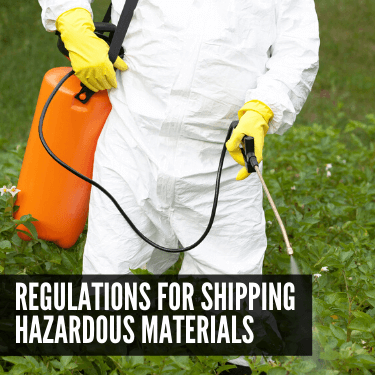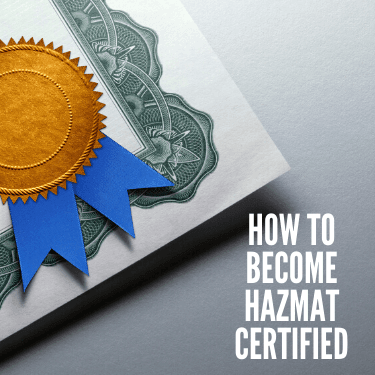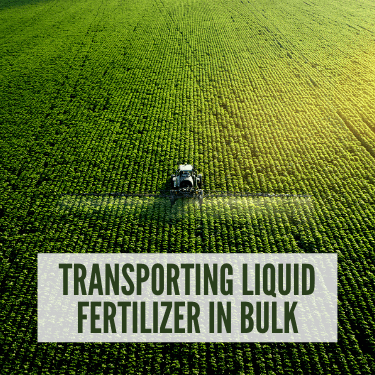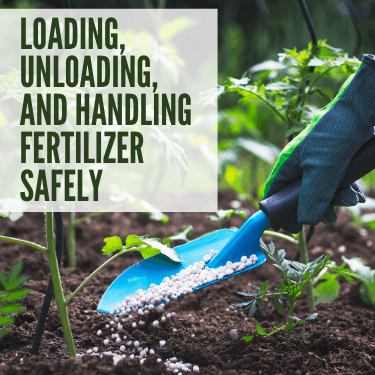Regardless of whether you’re a farmer or a large-scale distributor, bulk fertilizer transport is no easy task. There’s a lot that needs to be considered when dealing with large quantities of any product, but when that product can be inherently risky to move, then that adds even more stress into the mix. With countless regulations that need to be followed exactly, and multiple different government agencies regulating the transport of fertilizer, there can be a lot of pressure on shippers to do everything right. However, with a knowledgeable and certified carrier partner like R+L Global Logistics on your side, a little bit of that pressure can be taken off your shoulders.
Bulk fertilizer transport requires working with hazmat certified carriers and complying with the regulations of the EPA, DOT, and OSHA government agencies. You will also need to create and distribute a Safety Data Sheet to all individuals that would come into contact with your shipment, to keep everyone informed on how to handle your shipment.

The short answer is: yes, some fertilizers are considered hazardous materials, but not all of them. Certain fertilizers contain ingredients, like ammonium nitrate or sulfur, that makes them inherently dangerous. Other fertilizers are comprised of mostly composted organic material that isn’t reactive or dangerous, and therefore isn’t treated as a hazardous material. However, if you want to ship fertilizer around the United States, understanding what “hazardous material” entails is absolutely essential before you get started.
Hazardous materials are defined as any material that poses a risk to health, safety, property, and the environment. They are substances that are corrosive, flammable, explosive, toxic, or radioactive. The complete list of hazardous materials classifications is as follows:
Those might make it seem like hazardous materials are outlandish weapons and biohazards, and while those are definitely hazardous, the list actually encompasses many more inconspicuous products as well. This includes batteries, laundry detergent, nail polish, paint, airbags, and yes, fertilizer.
Most fertilizers contain ammonium nitrate, which is an oxidizing substance. That would mean that it is classified as Hazard Class 5.1. It is known to irritate eyes and lungs, and it can be a hazard to the environment if it spills in large quantities. However, depending on its other ingredients, it may require more than one classification.
For example, liquid fertilizers can sometimes ignite, making them a Hazard Class 3 Flammable Liquid. Dry fertilizers can sometimes be classified as Hazard Class 4.1 Highly Flammable Solids or 4.3 Dangerous When Wet. Many others are considered to be a Hazard Class 8 Corrosive as well. Fertilizers with sulfur may emit dangerous gases under the wrong conditions, making them a Hazard Class 2.2 Toxic Gas. However, some fertilizers won’t require any hazard classification at all.
In most cases, the manufacturer or importer should inform you of the proper hazard classifications, but that doesn’t mean it's a failsafe. You will still be held accountable for hazardous shipments that are misclassified, so you should always double-check the hazard classification to make sure it makes sense.
If, however, you need to determine the hazard class of the shipment yourself for whatever reason, you can look to the official Occupational Safety and Health Administration (OSHA) Guidance for Hazard Determination document for help.

When hazardous materials are being transported, they are referred to as “dangerous goods” by the Department of Transportation (DOT). As the shipper of fertilizer, aka dangerous goods, you would have several responsibilities for getting your shipment ready for transportation. These responsibilities include the following elements:
In addition to those requirements, you also need to ensure that the carrier you are working with is certified to move HazMat freight, and meets all the carrier requirements too. When you work with R+L Global Logistics, you know our network of reliable carriers contains some of the best in the industry, so you can feel confident leaving your shipment in our hands. Not only are our carriers HazMat certified, but we can also offer additional value-added services to get your shipment delivered faster and with more security than traditional shipping options. We can even offer customized solutions for any situation, to meet your unique needs.

Any employee involved in the packaging, preparation, shipping, receiving, or transporting of hazardous materials must complete a compliance course through a third-party that covers all the requirements detailed by the DOT. If you are in any way responsible for ensuring the compliance of a HazMat shipment, then you will need to become certified in this way. These courses also cover the other requirements for safety, security, and awareness training as well.
Courses are offered by a number of different companies, but it is important that you don’t just pick the option that is the cheapest. You need to make sure that the program you are applying to covers all of the requirements outlined by the DOT and EPA. If possible, look for any endorsements the company has, and use your best judgment to determine if they’re legitimate. The last thing you want is to pay for a course and then realize afterward that it didn’t cover everything it should have.
Once you have taken the training, however, be aware that the DOT is not the entity that certifies your compliance. Rather, the issuer of the exam, your employer, or you yourself must certify that you meet the requirements and understand the material, and keep accurate, current records of your training. Those training and exam records are what “certify” you to move HazMat freight, and they even allow you to provide this training to others, such as employees, coworkers, and management.
Every three years, you will need to repeat this training in its entirety, not just as a refresher. However, if there is a change in the laws that apply to you, then you will need to supplement your training with the new information as soon as possible.
Each of the different hazard classifications corresponds to a distinctly different label that is used to quickly identify them. These labels are universally understood, and can be easily identifiable from a considerable distance because of their bright colors and high-contrast lettering.
This is extremely important for if there is an accident or spill, since responders to the scene need to be able to determine the level of risk involved with approaching the material. Radioactive material can be harmful to people even from within a sealed container, and some materials emit a toxic vapor that is deadly to breathe. Being able to assess the materials and the risk from a distance allows responders to act appropriately to safely clean up the spill.
The labels themselves are bright, square stickers with universal symbols to show the kind of danger they pose—such as an illustration of fire to indicate flammability, or a skull to indicate poison. These stickers can be affixed to boxes, pallets, drums, or any other shipping unit. They should be positioned on their point, so the hazard class number is at the bottom, and placed as close to the UN number and other shipping information as possible. That should also be on the front of the package so that it is easy to see.
In addition to that, any freight truck carrying hazardous materials must also be labeled with large hazard placards, which you will be responsible for providing in most cases. These placards should represent the same hazards as the stickers, and they must appear on all four sides of the truck’s body. This regulation is in place not only to inform responders in the event of an accident about what they are dealing with, but also to warn other drivers about the dangerous material in the back of the truck. Civilians have a right to know about any potentially dangerous freight that could be on the road around them.

If you intend to distribute your shipment of dry fertilizer, then you’re going to need to package it for consumers. The best way to do that is with large, woven polypropylene or polyethylene bags. Usually, these bags are roughly 50kg (110lb) and must be fairly sturdy to ensure the fertilizer stays contained. The last thing you want is for the bags to rip open during, since at best that would make more work for you or potentially waste stock, and at worst, you would need to report the incident and call in a professional HazMat cleaning crew.
A good alternative to those bags is what’s known as flexible intermediate bulk containers (FIBC). These containers are also made of the same material, but it is much thicker and larger than the bags described above. FIBC, also called bulk bags, super sacks, or big bags, are gigantic and capable of containing up to a metric ton of fertilizer at one time. They are typically loaded up onto a pallet or strung up through loops in the top to be moved by forklift.
When packing fertilizer, it’s always best to do so in a low-moisture environment and to use bags that are water-tight. Dry fertilizer is notorious for clumping up when it gets damp, and that can be a huge hassle to deal with once it’s time for the fertilizer to be used. If you want to ensure the highest-quality product, then you’re going to need to watch your moisture levels.
If you opt to use the smaller bags to package your fertilizer, then you’re going to need to make it easier to move around in bulk quantities. This can be achieved by palletizing, which will also make the shipment easier to load onto a freight truck.
In order to palletize bagged freight, you need to utilize a slightly different technique than you would use with boxed goods. For one thing, there’s no need to put anything between the layers of bags, since that would actually end up compromising the integrity of the pallet instead of reinforcing it. You should also stagger the bags so their corners do not line up with each other, instead of stacking them in columns like you would with boxes. This gives the pallet some extra stability and makes it less likely to fall apart when it is jostled around.
Once you have a secure stack of bags on your pallet, you will need to wrap it with multiple layers of plastic wrap to keep everything together. You should also loop the plastic around the holes in the pallet to secure it to the bags—just make sure you don’t block the holes that the forklift uses to carry the pallet.
No matter how you decide to package your fertilizer shipment, make absolutely sure you treat it with care. When you’re dealing with hazardous materials, the consequences for ruptured bags and broken pallets affect much more than just your revenue. You could end up with a serious environmental or health crisis on your hands if your fertilizer spills and contaminates a water source.

Regardless of whether you’ve packaged your fertilizer in FBICs or on pallets, the most common choice for moving it domestically is with a standard freight truck. A typical 53-foot trailer, you can expect to fit 26 standard-sized pallets single stacked, or 52 pallets double stacked. However, before you consider stacking your pallets to save money, you need to honestly evaluate whether or not your pallets can withstand the weight of another pallet on top of them. In most cases with bagged freight, this isn’t realistic. You’d risk splitting the bags open if you try to exceed their weight capacity, and that’s just not a risk worth taking.
Alternatively, however, if your fertilizer isn’t packaged or palletized, either because you’re just shipping to your own farm or you’re sending it somewhere else to be bagged, there’s a more convenient option. Dry fertilizer can be loaded up onto a special tanker truck called a dry bulk tanker, which can carry up to 80,000 pounds of dry fertilizer at once—the legal weight limit for trucks on most U.S. roads. The tanks are shaped like funnels, so when it comes time to empty the tanks, it is easy to open up the funnels at the bottom and simply dump the fertilizer out.
As stated above, moisture is one of the biggest obstacles to preserving quality fertilizer. Dealing with fertilizer that has gotten clumpy is a huge hassle, and although it is still usable, it has to be crushed up again before it can be dispersed. For fertilizers with ammonium nitrate or other harmful chemicals, that can lead to overexposure and health consequences for the person crushing up the fertilizer again. Not only that, but dealing with clumpy fertilizer takes extra time to break up again, which can be even more frustrating for whoever accepts the fertilizer.
On a more gruesome note, serious injury can result from fertilizer that has become too compact. FIBCs are designed to be opened from the bottom while it is suspended in the air, by having a worker slice open the fabric with a blade over a large collection bin. If the fertilizer comes out as a giant, one-ton clump, that would come down onto the worker’s arm and cause severe injury. If that wasn’t bad enough, fertilizers with ammonium nitrate can combust if the storage and transport conditions become too humid.
In order to prevent injuries like that, it is imperative that you take the necessary steps to control the moisture levels of your shipment. Fertilizers should be kept at a relative humidity less than 40%, and they should be appropriately dried out prior to shipping. If the weather is humid or rainy, then additional steps should be taken to ensure moisture doesn’t enter the trailer. This isn’t easy though, since fluctuating temperatures can result in what’s known as “container sweat” to build up on the inside of the trailer. This condensation can, and frequently does, wreak havoc on fertilizer shipments.
There are a couple of ways to prevent this moisture buildup inside the trailer. Having a reflective exterior or decent heat transfer abilities can help to minimize condensation, and rerouting your trucker’s path to avoid bad weather can also help to keep temperatures and humidity levels consistent. Ensuring your pallets are dry before you stack on them is also an important factor to consider when dealing with such a moisture-sensitive shipment.
In addition to changing the way your shipment is handled, there is another option to reduce the moisture levels in a truck—through the use of what’s known as desiccants. Desiccants are drying agents used to absorb moisture in the air. Common desiccants include silica, activated charcoal, calcium sulfate, and calcium chloride. In fact, you may have even seen small silica packets in things like cured meats or leather shoes to maintain the proper dryness for those products. That same principle can be applied on a larger scale to your bulk fertilizer shipment.
Liquid fertilizer requires a little more careful consideration when it comes to packaging, since leaks can be a lot worse and get out of control a lot faster than with dry fertilizer.
In terms of packaging, you have several options depending on the quantity of fertilizer you intend to move. This includes plastic jugs, large plastic drums, and gigantic fertilizer storage tanks. You cannot use metal containers because of fertilizer’s tendency to corrode metal, whatever you choose has to be plastic. The most common choice for packaging fertilizer for shipping by far is Intermediate Bulk Containers (IBC), which are often referred to as tanks or totes.
IBC tanks are large plastic tanks about the size and dimensions of a loaded pallet, encased in a sturdy metal frame. That metal frame serves many purposes. It protects the thin plastic walls of the tank from bumping into other tanks, it provides enough structural strength to stack other tanks on top of it, and it is built with forklifts in mind. The bottom of the metal frame is designed to look like the bottom of a pallet, so forklifts can still be used to carry the tanks around as needed.
If you are using reconditioned or old IBC tanks, make sure you inspect them for quality and safety before you load them with fertilizer. The last thing you want is for the tank to spill because of weak or warped plastic, or bent metal poking a hole in the side. However, if your tanks are in good condition, there’s no reason not to reuse them again.

Like dry fertilizer, liquid fertilizer is also typically transported on a standard freight truck. Unlike with bagged dry fertilizer pallets, however, you can safely stack IBC tanks on top of each other because of their metal frame, so you can get the most out of your space. In addition to that, the tanks’ square shape allows more fertilizer to fit in the truck than if it was packed in round drums.
Also similar to dry fertilizer, you can use a tank truck to move liquid fertilizer as well. Liquid tank trucks are often utilized to move anything from gasoline to milk, and they are well equipped to accommodate hazardous fertilizer as well. This is a popular option because it can be used to transport a much larger quantity of fertilizer than the IBC tanks can on a regular truck, but you should make sure you’re working with an experienced carrier, like R+L Global Logistics. If your truck driver has never pulled a liquid tanker before, you could be in for some problems.
When a full-size tanker ruptures or leaks, then there is no way to stop it. Up to 80,000 pounds of liquid fertilizer would spill uncontrollably out into the streets, contaminating streams, drinking water, and farmland all over a wide radius. R+L Global Logistics can make sure your shipment is only handled by reliable truck drivers with years of experience hauling tank trucks and liquid IBC totes, so you can prevent a catastrophe like the one described above.
Need help with coal transportation by truck? See how an expert freight ally can help!

It is extremely important that all employees and workers are properly trained to handle the potentially dangerous chemicals, and all the equipment required to transport it. Carriers must be licensed to drive a tanker truck and certified to handle HazMat freight if either applies, and all hazards should be clearly identified from the outset.
In order to comply with OSHA laws, shippers need to create and provide a Safety Data Sheet that describes the details of the shipment, the safe methods for handling it, and what to do in the event of a disaster. In many cases, the manufacturer of the fertilizer should include the Safety Data Sheet for you, but as with other documentation, it is still the responsibility of the shipper to ensure it is complete and accurate.
The Safety Data Sheet should detail all the chemicals in the fertilizer, along with information about those chemicals’ properties. It should also include first aid measures, fire-fighting techniques, cleanup procedures, and whether the compound reacts when exposed to anything. If anything can go wrong, a plan for dealing with it should be in the Safety Data Sheet.
A copy of the Safety Data Sheet should be made available to every individual that will be coming into contact with the shipment so that everyone will know the danger it poses and how to handle it safely. Bulk fertilizer-related accidents can be catastrophic, but when no one knows what to do in the event of a fire, spill, or other accident, that exacerbates the potential damages to the environment, infrastructure, and human lives.
Bulk fertilizer transport can be stressful, but with R+L Global Logistics, you can take a back seat and let the experts handle everything for you. Our highly trained and reliable hazmat carrier partners can reduce your risk and liability, and offer superior support and communication for the entire time your shipment is in transit. If you need help with anything else too, such as farm equipment transport, shipping meat, or machinery shipping, you can count on us to provide the service you need.
With R+L Global Logistics, you could benefit from services like:
In addition to the range of varied services we offer, you could also take advantage of these benefits:
No matter what you have to ship, R+L Global Logistics can be your trusted partner. Call (866) 353-7178 today to request a freight quote!
R+L Global Logistics
315 NE 14th St., Ocala, FL 34470